
Solutions to SQA examination
Higher Grade Physics
2004
Return to past paper index page.
Section A
1. C 11. B
2. D 12. E
3. D 13. E
4. C 14. C
5. B 15. E SQA say D?
6. B 16. D
7. A 17. A
8. A 18. D
9. E 19. B
10.E 20. C
Section B
21.a. Speed is a scalar with magnitude only.
Velocity is a vector with magnitude and velocity.
b.i.Distance(1) = Speed x time
10.0km/h x 0.5h
5km
Distance(2) = 8.0km/h x 1.5
12km
Distance(Total) = Distance(1)+Distance(2)
Distance(Total) = 5km + 12km
Distance(Total) = 17km
b.ii.Draw an accurate scale diagram and take careful measurements
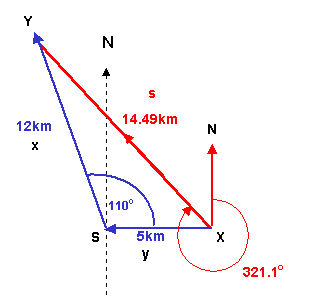 or use trigonometry.
Use the cosine rule to calculate the resultant displacement.
s2=x2 + y2 -2xycosX
s2=122 + 52 -2x12x5cos110o
s2=169 + 41.04
s = SQRT(210.4)
s =14.49km
Use the sine rule to calculate angle X and hence the bearing.
s/sinS = x/sinX
sinX = (xsinS)/s
sinX = (12sin110o)/14.49
sinX = (11.28)/14.49
sinX = 0.778
X = 51.1o
bearing 321.1o
b.iii.velocity = displacement/time
s = 14.49km v = 14.49/2
t = 2 h v = 7.24km/h
c. Time for Leeuvin to sail directly:
t = s/v
t = 14.49/7.5
t = 1.932h = 1hour 55.9minutes
Time for Leeuvin to reach Y after the Mir passes X
1h 55.9min + 15min = 2h 10.9min
This is longer than the 2h journey of the Mir.
Leeuvin reaches Y 10.9 minutes after Mir.
22.a.i.u = 60m/s v2 = u2 + 2as
v = 0m/s s = (v2 - u2)/2a
t = 40s
s = ? a = (v-u)/t
a = (0 - 60)/40 = -1.5m/s/s
s = (02 - 602)/2x-1.5
s = -3600/-3
s = 1200m
a.ii.Favg = m(v-u)/t
m = 7.5x105kg Favg = 7.5x105(0-60)/40
u = 60m/s Favg = -11.25x105N
v = 0m/s The force acts in the opposite direction
t = 40s to the motion.
Kinetic energy equated to the work done by the braking
force also produces the above answer.
b. Irms = 2.5x103A Prms = Irms x Vrms
P = 8.5x106(J/s) or (W) Vrms = Prms/Irms
Vrms = 8.5x106/2.5x103
Vrms = 3400V
23.a. As the manifold is stationary the upward forces
balance the downward forces. Tension = Weight
or use trigonometry.
Use the cosine rule to calculate the resultant displacement.
s2=x2 + y2 -2xycosX
s2=122 + 52 -2x12x5cos110o
s2=169 + 41.04
s = SQRT(210.4)
s =14.49km
Use the sine rule to calculate angle X and hence the bearing.
s/sinS = x/sinX
sinX = (xsinS)/s
sinX = (12sin110o)/14.49
sinX = (11.28)/14.49
sinX = 0.778
X = 51.1o
bearing 321.1o
b.iii.velocity = displacement/time
s = 14.49km v = 14.49/2
t = 2 h v = 7.24km/h
c. Time for Leeuvin to sail directly:
t = s/v
t = 14.49/7.5
t = 1.932h = 1hour 55.9minutes
Time for Leeuvin to reach Y after the Mir passes X
1h 55.9min + 15min = 2h 10.9min
This is longer than the 2h journey of the Mir.
Leeuvin reaches Y 10.9 minutes after Mir.
22.a.i.u = 60m/s v2 = u2 + 2as
v = 0m/s s = (v2 - u2)/2a
t = 40s
s = ? a = (v-u)/t
a = (0 - 60)/40 = -1.5m/s/s
s = (02 - 602)/2x-1.5
s = -3600/-3
s = 1200m
a.ii.Favg = m(v-u)/t
m = 7.5x105kg Favg = 7.5x105(0-60)/40
u = 60m/s Favg = -11.25x105N
v = 0m/s The force acts in the opposite direction
t = 40s to the motion.
Kinetic energy equated to the work done by the braking
force also produces the above answer.
b. Irms = 2.5x103A Prms = Irms x Vrms
P = 8.5x106(J/s) or (W) Vrms = Prms/Irms
Vrms = 8.5x106/2.5x103
Vrms = 3400V
23.a. As the manifold is stationary the upward forces
balance the downward forces. Tension = Weight
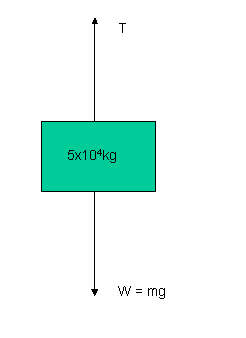 w = mg
w = 5.0x104kg x 9.8N/kg
w = 490000N
T = 490000N (upwards)
b.i.
w = mg
w = 5.0x104kg x 9.8N/kg
w = 490000N
T = 490000N (upwards)
b.i.
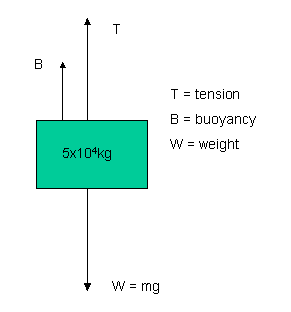 b.ii.Again as the manifold is stationary the upward forces
balance the downward forces.
T + B = W
2.5x105 + B = 490000N
B = 490000 - 250000
B = 240000N
The buoyancy force is a result of the pressure
difference between the upper and lower surfaces.
B = (Plower-Pupper)A
DP = B/A
DP = 240000N/8.0m2
DP = 30000Pa As required
c. There is no change in the pressure difference.
Pliquid(top) = rgh
Pliquid(bottom) = rg(h+Dh)
DP = Pliquid(bottom) - Pliquid(top)
DP = rgDh
b.ii.Again as the manifold is stationary the upward forces
balance the downward forces.
T + B = W
2.5x105 + B = 490000N
B = 490000 - 250000
B = 240000N
The buoyancy force is a result of the pressure
difference between the upper and lower surfaces.
B = (Plower-Pupper)A
DP = B/A
DP = 240000N/8.0m2
DP = 30000Pa As required
c. There is no change in the pressure difference.
Pliquid(top) = rgh
Pliquid(bottom) = rg(h+Dh)
DP = Pliquid(bottom) - Pliquid(top)
DP = rgDh
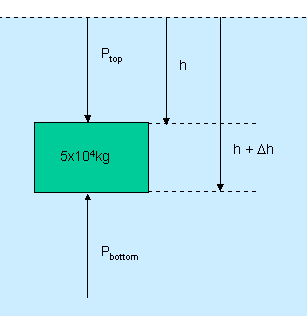 Only the difference in the depth(Dh) of the top and
bottom surfaces affects the pressure difference.
24.a.i.r = 2.0W
emf = 9.0V (open circuit voltage)
Vtpd = 7.8V
Vlost = emf - Vtpd
Vlost = 9.0 - 7.8
Vlost = 1.2V
Vlost = Ir
I = Vlost/r
I = 1.2/2.0
I = 0.6A
Vtpd = VR
VR = IR
R = VR/I
R = 7.8/0.6
R = 13W
24.a.ii.When S1 is closed there is a current through the internal
resistor. The voltage drop across this resistor is "lost"
and produces the decreased reading on the voltmeter.
b. The 30W resistor in parallel with the original
load resistor decreases the effective resistance
of the load. More current therefore flows through
the internal resistor resulting in more "lost volts".
This means the voltmeter reading decreases.
25.a.
Only the difference in the depth(Dh) of the top and
bottom surfaces affects the pressure difference.
24.a.i.r = 2.0W
emf = 9.0V (open circuit voltage)
Vtpd = 7.8V
Vlost = emf - Vtpd
Vlost = 9.0 - 7.8
Vlost = 1.2V
Vlost = Ir
I = Vlost/r
I = 1.2/2.0
I = 0.6A
Vtpd = VR
VR = IR
R = VR/I
R = 7.8/0.6
R = 13W
24.a.ii.When S1 is closed there is a current through the internal
resistor. The voltage drop across this resistor is "lost"
and produces the decreased reading on the voltmeter.
b. The 30W resistor in parallel with the original
load resistor decreases the effective resistance
of the load. More current therefore flows through
the internal resistor resulting in more "lost volts".
This means the voltmeter reading decreases.
25.a.
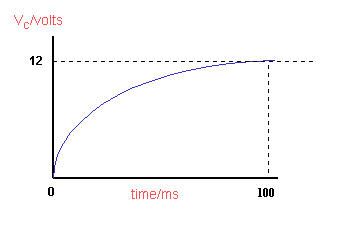 When fully charged the current in the circuit falls to
zero and the voltage across the capacitor is equal to the
supply voltage.
25.bi. I = 20mA
R = 400W
VR = IR
VR = 20x10-3x400
VR = 8V
Vsupply = VR + VC
VC = Vsupply - VR
VC = 12 - 8
VC = 4V
b.ii. E = 1/2(CV2)
E = 0.5 x 100x10-6 x 42
E = 0.0008J (800mJ)
c. Reduce the value of the resistor in the circuit
to less than 400W.
d. The charging time is less. This means the capacitor
must have a value less than 400mF
26.a. Differential op-amp
Vout = (Rf/R1)(V2-V1)
Vout = (120/10)(7.52-7.50)
Vout = 12 x 0.02
Vout = 0.24V
b. As the temperature increases the:
Resistance of the thermistor decreases increasing V2 and Vout.
When Vout increases to 0.7V or above the transistor conducts.
The electromagnet in the relay gets magnitised and closes
the switch to the alarm.
c. Vout = (Rf/R1)(V2-V1)
0.72 = 12(V2 - 7.50)
V2 = (0.72/12) + 7.50
V2 = 0.06 + 7.50
V2 = 7.56V
This corresponds to a temperature of 36oC
27.a.i.Angle air = 82o
Angle liquid = 45o
nliquid(red) = sin(air)/sin(liquid)
nliqiud(red) = sin82o/sin45o
nliquid(red) = 0.990/0.707
nliquid(red) = 1.40
a.ii.The angle of refraction for blue light is greater.
sinqair = nsinqliquid
qair = sin-1(nsinqliquid)
As nliquid(blue) > liquid(red) qair must be greater.
Note: qair is the angle of refraction.
b. qcritical = sin-1(1/n)
qcritical = sin-1(1/1.44)
qcritical = sin-1(0.694)
qcritical = 43.9o
This means that light incident at 45o will be totally
internally reflected.
When fully charged the current in the circuit falls to
zero and the voltage across the capacitor is equal to the
supply voltage.
25.bi. I = 20mA
R = 400W
VR = IR
VR = 20x10-3x400
VR = 8V
Vsupply = VR + VC
VC = Vsupply - VR
VC = 12 - 8
VC = 4V
b.ii. E = 1/2(CV2)
E = 0.5 x 100x10-6 x 42
E = 0.0008J (800mJ)
c. Reduce the value of the resistor in the circuit
to less than 400W.
d. The charging time is less. This means the capacitor
must have a value less than 400mF
26.a. Differential op-amp
Vout = (Rf/R1)(V2-V1)
Vout = (120/10)(7.52-7.50)
Vout = 12 x 0.02
Vout = 0.24V
b. As the temperature increases the:
Resistance of the thermistor decreases increasing V2 and Vout.
When Vout increases to 0.7V or above the transistor conducts.
The electromagnet in the relay gets magnitised and closes
the switch to the alarm.
c. Vout = (Rf/R1)(V2-V1)
0.72 = 12(V2 - 7.50)
V2 = (0.72/12) + 7.50
V2 = 0.06 + 7.50
V2 = 7.56V
This corresponds to a temperature of 36oC
27.a.i.Angle air = 82o
Angle liquid = 45o
nliquid(red) = sin(air)/sin(liquid)
nliqiud(red) = sin82o/sin45o
nliquid(red) = 0.990/0.707
nliquid(red) = 1.40
a.ii.The angle of refraction for blue light is greater.
sinqair = nsinqliquid
qair = sin-1(nsinqliquid)
As nliquid(blue) > liquid(red) qair must be greater.
Note: qair is the angle of refraction.
b. qcritical = sin-1(1/n)
qcritical = sin-1(1/1.44)
qcritical = sin-1(0.694)
qcritical = 43.9o
This means that light incident at 45o will be totally
internally reflected.
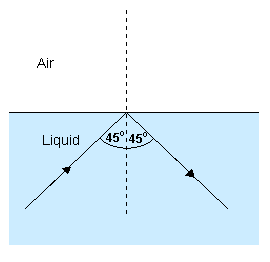 28.a.i.A passing photon can encourage or stimulate an electron
to fall from a higher energy level in an atom to a lower
one. This will happen if the passing photon has the same
energy as the energy gap between the two energy levels
in the atom.
a.ii.Amplification is produced because each photon produced by
stimulated emission becomes a new stimulating photon. One
becomes two, two becomes four, four becomes eight and so on.
b. Grating Equation : dsinq = nl
d = ?m
n = 1
q = 37/2o =18.5o
l = 633nm = 633 x10-9m
d = nl/sinq
d = 1 x 633 x10-9/sin18.5o
d = 1.995x10-6m
Lines per metre = 1/d
Lines per metre = 1/1.995x10-6
Lines per metre = 501271
c. The wavelength has been decreased. Shorter wavelengths
are diffracted less than longer ones so the maxima are
closer together.
29.a.
28.a.i.A passing photon can encourage or stimulate an electron
to fall from a higher energy level in an atom to a lower
one. This will happen if the passing photon has the same
energy as the energy gap between the two energy levels
in the atom.
a.ii.Amplification is produced because each photon produced by
stimulated emission becomes a new stimulating photon. One
becomes two, two becomes four, four becomes eight and so on.
b. Grating Equation : dsinq = nl
d = ?m
n = 1
q = 37/2o =18.5o
l = 633nm = 633 x10-9m
d = nl/sinq
d = 1 x 633 x10-9/sin18.5o
d = 1.995x10-6m
Lines per metre = 1/d
Lines per metre = 1/1.995x10-6
Lines per metre = 501271
c. The wavelength has been decreased. Shorter wavelengths
are diffracted less than longer ones so the maxima are
closer together.
29.a.
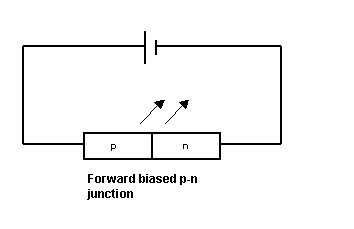 b. In forward bias the junction conducts if the applied
voltage is high enough. Higher energy electrons flowing
from the n-type material fall into holes, at a lower energy
level, in the p-type material. The electrons give up energy
in the form of photons as they do this.
c.i. E = 3.68x10-19J E = hf
h = 6.63x10-34Js f = E/h
f = ? f = 3.68x10-19/6.63x10-34
f = 5.55x1014Hz
l = v/f
l = 3x108/5.55x1014
l = 540nm
ii. E = 3.68x10-19J E = qV
q = 1.60x10-19C V = E/q
V = V = 3.68x10-19/1.60x10-19
V = 2.3V
30.a.i. 92 is the atomic number. The number of protons
in the uranium nucleus.
a.ii.235 is the mass number. The number of protons
plus neutrons in the uranium nucleus.
b. The two neutrons produced in the fission reaction
can be absorbed by two other uranium nuclei and
produce two more fissions.
c. Total mass before = (390.173 + 1.675)x10-27
= 391.848x10-27kg
Total mass after = (232.242 + 155.884 + 2x1.675)x10-27
391.476x10-27kg
Mass defect(Dm) = (391.848 - 391.476)x10-27
= 0.372x10-27kg
E = Dmc2
E = 0.372x10-27 x (3x108)2
E = 33.48x10-12J
b. In forward bias the junction conducts if the applied
voltage is high enough. Higher energy electrons flowing
from the n-type material fall into holes, at a lower energy
level, in the p-type material. The electrons give up energy
in the form of photons as they do this.
c.i. E = 3.68x10-19J E = hf
h = 6.63x10-34Js f = E/h
f = ? f = 3.68x10-19/6.63x10-34
f = 5.55x1014Hz
l = v/f
l = 3x108/5.55x1014
l = 540nm
ii. E = 3.68x10-19J E = qV
q = 1.60x10-19C V = E/q
V = V = 3.68x10-19/1.60x10-19
V = 2.3V
30.a.i. 92 is the atomic number. The number of protons
in the uranium nucleus.
a.ii.235 is the mass number. The number of protons
plus neutrons in the uranium nucleus.
b. The two neutrons produced in the fission reaction
can be absorbed by two other uranium nuclei and
produce two more fissions.
c. Total mass before = (390.173 + 1.675)x10-27
= 391.848x10-27kg
Total mass after = (232.242 + 155.884 + 2x1.675)x10-27
391.476x10-27kg
Mass defect(Dm) = (391.848 - 391.476)x10-27
= 0.372x10-27kg
E = Dmc2
E = 0.372x10-27 x (3x108)2
E = 33.48x10-12J
END OF QUESTION PAPER
Return to past paper index page.


or use trigonometry. Use the cosine rule to calculate the resultant displacement. s2=x2 + y2 -2xycosX s2=122 + 52 -2x12x5cos110o s2=169 + 41.04 s = SQRT(210.4) s =14.49km Use the sine rule to calculate angle X and hence the bearing. s/sinS = x/sinX sinX = (xsinS)/s sinX = (12sin110o)/14.49 sinX = (11.28)/14.49 sinX = 0.778 X = 51.1o bearing 321.1o b.iii.velocity = displacement/time s = 14.49km v = 14.49/2 t = 2 h v = 7.24km/h c. Time for Leeuvin to sail directly: t = s/v t = 14.49/7.5 t = 1.932h = 1hour 55.9minutes Time for Leeuvin to reach Y after the Mir passes X 1h 55.9min + 15min = 2h 10.9min This is longer than the 2h journey of the Mir. Leeuvin reaches Y 10.9 minutes after Mir. 22.a.i.u = 60m/s v2 = u2 + 2as v = 0m/s s = (v2 - u2)/2a t = 40s s = ? a = (v-u)/t a = (0 - 60)/40 = -1.5m/s/s s = (02 - 602)/2x-1.5 s = -3600/-3 s = 1200m a.ii.Favg = m(v-u)/t m = 7.5x105kg Favg = 7.5x105(0-60)/40 u = 60m/s Favg = -11.25x105N v = 0m/s The force acts in the opposite direction t = 40s to the motion. Kinetic energy equated to the work done by the braking force also produces the above answer. b. Irms = 2.5x103A Prms = Irms x Vrms P = 8.5x106(J/s) or (W) Vrms = Prms/Irms Vrms = 8.5x106/2.5x103 Vrms = 3400V 23.a. As the manifold is stationary the upward forces balance the downward forces. Tension = Weight
w = mg w = 5.0x104kg x 9.8N/kg w = 490000N T = 490000N (upwards) b.i.
b.ii.Again as the manifold is stationary the upward forces balance the downward forces. T + B = W 2.5x105 + B = 490000N B = 490000 - 250000 B = 240000N The buoyancy force is a result of the pressure difference between the upper and lower surfaces. B = (Plower-Pupper)A DP = B/A DP = 240000N/8.0m2 DP = 30000Pa As required c. There is no change in the pressure difference. Pliquid(top) = rgh Pliquid(bottom) = rg(h+Dh) DP = Pliquid(bottom) - Pliquid(top) DP = rgDh
Only the difference in the depth(Dh) of the top and bottom surfaces affects the pressure difference. 24.a.i.r = 2.0W emf = 9.0V (open circuit voltage) Vtpd = 7.8V Vlost = emf - Vtpd Vlost = 9.0 - 7.8 Vlost = 1.2V Vlost = Ir I = Vlost/r I = 1.2/2.0 I = 0.6A Vtpd = VR VR = IR R = VR/I R = 7.8/0.6 R = 13W 24.a.ii.When S1 is closed there is a current through the internal resistor. The voltage drop across this resistor is "lost" and produces the decreased reading on the voltmeter. b. The 30W resistor in parallel with the original load resistor decreases the effective resistance of the load. More current therefore flows through the internal resistor resulting in more "lost volts". This means the voltmeter reading decreases. 25.a.
When fully charged the current in the circuit falls to zero and the voltage across the capacitor is equal to the supply voltage. 25.bi. I = 20mA R = 400W VR = IR VR = 20x10-3x400 VR = 8V Vsupply = VR + VC VC = Vsupply - VR VC = 12 - 8 VC = 4V b.ii. E = 1/2(CV2) E = 0.5 x 100x10-6 x 42 E = 0.0008J (800mJ) c. Reduce the value of the resistor in the circuit to less than 400W. d. The charging time is less. This means the capacitor must have a value less than 400mF 26.a. Differential op-amp Vout = (Rf/R1)(V2-V1) Vout = (120/10)(7.52-7.50) Vout = 12 x 0.02 Vout = 0.24V b. As the temperature increases the: Resistance of the thermistor decreases increasing V2 and Vout. When Vout increases to 0.7V or above the transistor conducts. The electromagnet in the relay gets magnitised and closes the switch to the alarm. c. Vout = (Rf/R1)(V2-V1) 0.72 = 12(V2 - 7.50) V2 = (0.72/12) + 7.50 V2 = 0.06 + 7.50 V2 = 7.56V This corresponds to a temperature of 36oC 27.a.i.Angle air = 82o Angle liquid = 45o nliquid(red) = sin(air)/sin(liquid) nliqiud(red) = sin82o/sin45o nliquid(red) = 0.990/0.707 nliquid(red) = 1.40 a.ii.The angle of refraction for blue light is greater. sinqair = nsinqliquid qair = sin-1(nsinqliquid) As nliquid(blue) > liquid(red) qair must be greater. Note: qair is the angle of refraction. b. qcritical = sin-1(1/n) qcritical = sin-1(1/1.44) qcritical = sin-1(0.694) qcritical = 43.9o This means that light incident at 45o will be totally internally reflected.
28.a.i.A passing photon can encourage or stimulate an electron to fall from a higher energy level in an atom to a lower one. This will happen if the passing photon has the same energy as the energy gap between the two energy levels in the atom. a.ii.Amplification is produced because each photon produced by stimulated emission becomes a new stimulating photon. One becomes two, two becomes four, four becomes eight and so on. b. Grating Equation : dsinq = nl d = ?m n = 1 q = 37/2o =18.5o l = 633nm = 633 x10-9m d = nl/sinq d = 1 x 633 x10-9/sin18.5o d = 1.995x10-6m Lines per metre = 1/d Lines per metre = 1/1.995x10-6 Lines per metre = 501271 c. The wavelength has been decreased. Shorter wavelengths are diffracted less than longer ones so the maxima are closer together. 29.a.
b. In forward bias the junction conducts if the applied voltage is high enough. Higher energy electrons flowing from the n-type material fall into holes, at a lower energy level, in the p-type material. The electrons give up energy in the form of photons as they do this. c.i. E = 3.68x10-19J E = hf h = 6.63x10-34Js f = E/h f = ? f = 3.68x10-19/6.63x10-34 f = 5.55x1014Hz l = v/f l = 3x108/5.55x1014 l = 540nm ii. E = 3.68x10-19J E = qV q = 1.60x10-19C V = E/q V = V = 3.68x10-19/1.60x10-19 V = 2.3V 30.a.i. 92 is the atomic number. The number of protons in the uranium nucleus. a.ii.235 is the mass number. The number of protons plus neutrons in the uranium nucleus. b. The two neutrons produced in the fission reaction can be absorbed by two other uranium nuclei and produce two more fissions. c. Total mass before = (390.173 + 1.675)x10-27 = 391.848x10-27kg Total mass after = (232.242 + 155.884 + 2x1.675)x10-27 391.476x10-27kg Mass defect(Dm) = (391.848 - 391.476)x10-27 = 0.372x10-27kg E = Dmc2 E = 0.372x10-27 x (3x108)2 E = 33.48x10-12J